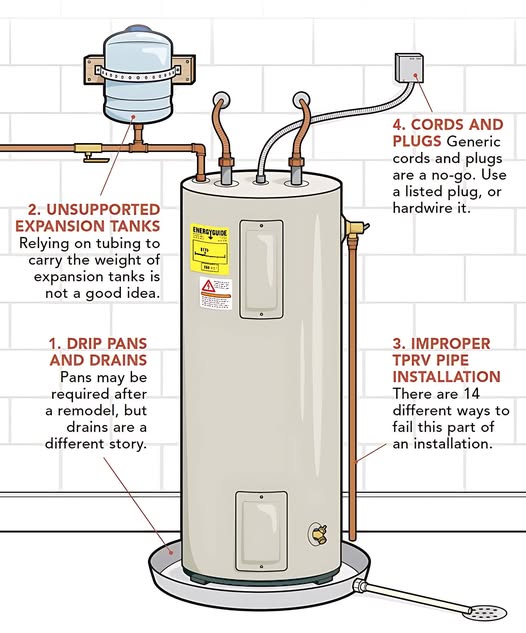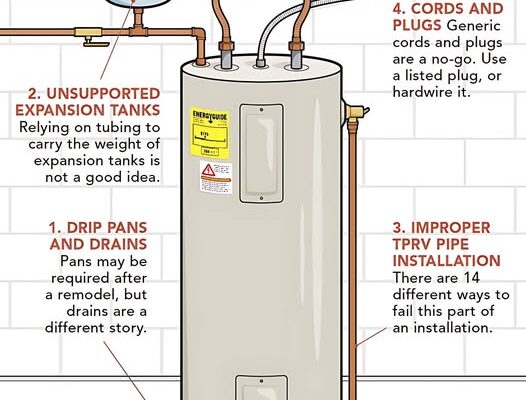This image shows a water heater and highlights common installation mistakes.
The Central Element: The Water Heater
- A cylindrical tank with plumbing connections at the top and potentially a drain valve near the bottom.
- It’s sitting in a drip pan with a drain line.
The Highlighted Mistakes:
The image labels and points out four common errors during water heater installation:
1. DRIP PANS AND DRAINS:
- The text states, “Pans may be required after a remodel, but drains are a different story.”
- This suggests that simply placing a drip pan under the water heater without a proper drain line to carry away any leaks is an insufficient or incorrect solution. The pan itself won’t prevent damage if a significant leak occurs.
2. UNSUPPORTED EXPANSION TANKS:
- An expansion tank is shown connected to the hot water line above the water heater.
- The text emphasizes, “Relying on tubing to carry the weight of expansion tanks is not a good idea.”
- Expansion tanks can be heavy when full of water. If their weight is solely supported by the copper or other tubing connecting them, it can stress the pipes, potentially leading to leaks or damage over time. Expansion tanks should be securely mounted to a wall or other structural support.
3. IMPROPER TPRV PIPE INSTALLATION:
- A pipe is shown extending from the Temperature and Pressure Relief Valve (TPRV) on the side of the water heater and running down towards the floor.
- The text warns, “There are 14 different ways to fail this part of an installation.”
- The TPRV is a crucial safety device that releases excess pressure or temperature to prevent explosions. Its discharge pipe must be installed correctly:
- It should be the proper material and diameter.
- It should run downhill and terminate within 6 inches of the floor or an approved drain.
- It should not be threaded, capped, or restricted in any way.
- The image likely depicts one of the incorrect ways, though the specific error isn’t explicitly detailed visually.

4. CORDS AND PLUGS:
- An electrical cord and plug are shown connected to the water heater and plugged into a standard wall outlet.
- The text states, “Generic cords and plugs are a no-go. Use a listed plug, or hardwire it.”
- Many water heaters, especially larger electric models, require a dedicated, properly wired circuit and should be hardwired directly to the electrical system. Using a standard extension cord or an unapproved plug can be a fire hazard and may not provide sufficient power. Some smaller electric water heaters might use a specific, listed plug designed for high-amperage appliances.
In summary, the image serves as a visual guide highlighting common mistakes to avoid when installing a water heater, focusing on proper drainage for the drip pan, secure support for the expansion tank, correct installation of the TPRV discharge pipe, and appropriate electrical connections.



